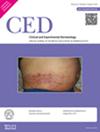A modified tissue-saving technique with silver nitrate to obliterate tunnels for hidradenitis suppurativa.
IF 2.8
4区 医学
Q1 DERMATOLOGY
引用次数: 0
改良硝酸银保存组织技术消除化脓性汗腺炎隧道。
化脓性汗腺炎(HS)是一种慢性炎症性皮肤病,以复发性结节、脓肿、窦道引流和瘢痕形成为特征,主要影响三节间区。相关的疼痛、引流和疤痕显著降低了患者的生活质量。HS病变的手术干预包括切除、传统的清创技术和一种更简单的小型清创方法(穿孔清创)。在这里,我们提出了一种进一步的改进,即在隧道中应用硝酸银来实现隧道堵塞和加速愈合。一名患有赫尔利期HS的41岁女性,尽管接受了多轮抗生素和类固醇注射,但仍出现了一个结节,并发展成一个隧道,引起了相当大的不适。在3周的随访中,进行了微型开挖技术,然后将硝酸银应用于隧道,隧道完全溶解。硝酸银的应用比传统的去除方法有几个优点,包括减少手术时间和更快的愈合,因为伤口表面积最小。硝酸银促进化学清创,促进快速和少痛苦的恢复。此外,这种临床程序不需要专门的访问,使其成为管理HS的方便和有效的选择,特别是在早期疾病患者中。
本文章由计算机程序翻译,如有差异,请以英文原文为准。
求助全文
约1分钟内获得全文
求助全文
来源期刊
CiteScore
3.20
自引率
2.40%
发文量
389
审稿时长
3-8 weeks
期刊介绍:
Clinical and Experimental Dermatology (CED) is a unique provider of relevant and educational material for practising clinicians and dermatological researchers. We support continuing professional development (CPD) of dermatology specialists to advance the understanding, management and treatment of skin disease in order to improve patient outcomes.

 求助内容:
求助内容: 应助结果提醒方式:
应助结果提醒方式:


